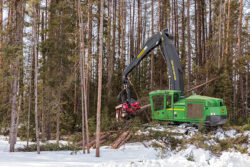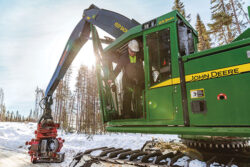
Features
Harvesting
Maintenance
Winter maintenance essentials
Cold-weather considerations for winterizing logging equipment
November 28, 2023 By Lasse Aalto and Kevin Drake
 Loggers operating in cold weather are encouraged to keep a close eye on their parts and fluid levels.
Photos courtesy John Deere.
Loggers operating in cold weather are encouraged to keep a close eye on their parts and fluid levels.
Photos courtesy John Deere. As loggers brace for cold weather conditions, keeping machines up and running is a top priority. As temperatures begin to drop. There are a variety of key areas loggers should focus on, including adopting maintenance best practices, adjusting machine settings and checking in on parts and fluid levels to ensure they are ready to tackle the job at hand, even during the most severe winter weather.
The following maintenance recommendations may not apply to all machine platforms and models. It is recommended that for specific intervals and guidelines you follow your manufacturer recommendations typically outlined in the operator manual.
General machine maintenance
As soon as temperatures trend toward freezing conditions, it is pivotal that loggers maintain their machines to prevent unnecessary downtime and focus on sustaining ideal grease and fluid levels, which are essential to general machine health. As part of the machine’s recommended maintenance plan, all bearings should be carefully greased to purge them of condensed water. Water should also be drained from the boom base, slew unit and water fuel separator.
Next, the saw unit and chain tensioner should be carefully cleaned out and greased regularly. Also receiving a careful routine greasing are the diameter sensors and the bogie articulation bearings, helping to keep your machine up and running in any weather condition. Regularly performing these steps during winter months can be incredibly worthwhile, as built-up dirt, debris and snow can freeze, making maintenance procedures more difficult to perform.
Check your parts and fluids
Loggers operating in cold weather are encouraged to keep a close eye on their parts and fluid levels. Before tackling logging applications in the winter, all batteries should be checked to confirm they are in optimal condition and replaced if needed. Fuel should also be replaced with winter-grade fuel. If replaced early enough in the season, this step can help to avoid machine malfunctions and filter clogging.

Before tackling logging applications in winter, all batteries should be checked to confirm they are in optimal condition and replaced if needed.
Operators should also make sure they have an additional set of fuel filters in stock in case the temperature drops below the recommended fuel cloud point. John Deere recommends using winter grade fuel when temperatures fall below 0 C.
When looking at hydraulic oils, higher viscosity index (VI) oils can manage a wider range of temperatures than standard oils. Standard grade 46 oil typically can manage temperatures as cold as -15 C, while higher VI oils can manage temperatures as cool as -25 C. To best ensure the correct oil is being utilized, loggers should consult with their local dealer or oil supplier.
Before firing up the machine, check the temperatures to confirm your machine can sustain a cold start-up. Also, completely changing over to suitable grade oil can help sustain performance in extreme temperatures. Operators should measure the coolant freezing temperatures, as certain coolants will completely freeze in extreme temperatures. Also being swapped out in cold-weather conditions is the grease in the central lubrication system to ensure the grease classification is suitable for the temperatures at hand.
Moving away from fluids, loggers are encouraged to check their machine’s chains, tracks and tires to check that the traction studs have sufficient lifetime remaining. If the high floatation tracks have been used year-round, loggers should check that their tracks are suitable for winter use and that no damage was done during the summer months. Lastly, tire air pressures should be checked for winter use, as the pressure in the tires can decrease in cold temperatures.
Warm up your machine
When getting ready to tackle the cold weather conditions from inside the cab, always conduct a performance check of the pre-heater functions and perform a test run to ensure that the machine is ready for use. Also, the oils and coolants in the winter grade help ensure the viscosity is suitable for winter use.
All loggers working in the winter should familiarize themselves with the warmup procedure, as well as how to conduct a cold start-up on their machines. This includes checking in on the machine’s hydraulics and saw motors before tackling routine applications. Also focusing on hydraulics, operators should always warm up the machine’s work hydraulics before operating, especially if the temperature of the hydraulic fluid is below 0 C.
After the machine is running, start the warmup cycle of feed rollers and wait at least five minutes as a best practice. Once the time has passed, let the feed rollers rotate and start to move articulations of the boom, using small movements and keeping the boom unloaded.
Another best practice is to let the engine idle and run the saw motor to warm it up and ensure that the temperature difference between the motor and the hydraulic fluid is always below 30 C. Use all the functions of the harvester head until the hydraulic fluid is warmed up to the ideal operating temperature.
When utilizing a harvester head, adjust the settings to ensure optimal performance. Adjust the pressure curves for frozen wood and calibrate the length and diameter measurements as needed. Lastly, check your saw to ensure all adjustments have been completed before tackling forestry applications.
Cold-weather considerations
Also helping to keep operators up and running during extreme weather conditions, cabins should be properly lubricated at the locks, and doors should be sealed with silicone to prevent them from freezing completely, helping to avoid the cabin door from becoming frozen shut. It is also important to check that the water valve and hot air supply are working properly, ensuring that cabin stays warm for the operator.

Cabin doors should be sealed with silicone to prevent from becoming frozen shut.
As the winter months may impact daytime visibility in the woods, loggers are encouraged to utilize proper lighting to protect themselves, as well as the other machines and operators around them. Before heading out to the job, double check that the light package is fully functional before the darkness hits, helping to prevent necessary damage. Also, considering that the days are shorter during winter, machines will often operate during night and after the sun has gone down. Therefore, the working light of the machine should be fully operational.
During a standard winter day, your equipment’s components will warm-up naturally with the heat of the machine, helping to remove snow and ice. However, at the end of the day, operators should always clean out any remaining snow from critical places where it may freeze overnight.
In addition, the saw box on harvester heads and feed roller arms areas are vital areas to double-check before heading home at the end of the day. Operators should also park the machine on an area where the snow is packed down and should place the boom straight down for simplified start-up on the next shift. This also enables an operator to lift the harvester head without unnecessarily folding of the boom when the hydraulic system is cold.
Harsh winter weather conditions can transform a jobsite entirely, and focusing on warming up all machines, checking fluid levels and parts, and performing routing machine maintenance are essential to year-round success. In extreme weather conditions, operators are also encouraged to look after themselves as well, not just their machines, and wear the appropriate gear and bring the necessary tools to stay warm on the job.
Lasse Aalto is the manager, technical support and DTAC, while Kevin Drake is the manager, forestry customer and product support for John Deere.
Print this page